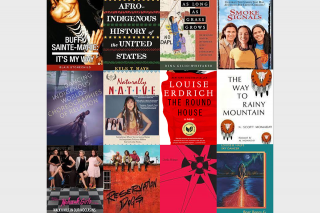November is Native American Heritage Month, established by the United States government to celebrate Indigenous history and culture with relevant programs, ceremonies, and activities. For many First Nations peoples, storytelling is a crucial aspect of the Indigenous experience and worldview. Accordingly, we share our recommendations for inspiring stories portrayed in Native novels, poetry, monographs, film, and television.
The Colleges of the Fenway recognize the Wampanoag, Massachusett, Nipmuc, and Abenaki tribes as the ancestral occupants of the lands on which our institutions are built. We honor and respect their stewardship of these territories and natural resources.
An Afro-Indigenous History of the United States (Beacon Press, 2022) by Kyle T. Mays (Saginaw-Chippewa). In this revelatory text, historian Kyle T. Mays argues that the United States was founded upon anti-Blackness and settler colonialism, and that these systems of oppression still operate in contemporary society. Nevertheless, Black and Indigenous peoples continue to fight for justice and equity.
Bear Bones and Feathers (Coteau Books, 1994) by Louise Bernice Halfe, a.k.a. Sky Dancer (Cree). Sky Dancer is Canada’s Poet Laureate, and she delivered a poetry reading at Simmons for Indigenous Peoples’ Day in 2023. As someone who experienced cultural genocide at the residential schools, her poems are acts of resistance and resilience. For Simmons Professor Emeritus of English David Gullette, a friend of Sky Dancer, her poetry “often draws from a deep well of trauma and sorrow… and out of this dreadful experience she became a victor and a poet.”
Buffy Sainte-Marie: It’s My Way (Fifth House Publishers, 2012) by Blair Stonechild (Muscowpetung). Indigenous singer/songwriter Buffy Sainte-Marie (Piapot Cree) emerged in the 1960s against a backdrop of revolution and change. Her songs fuel hope and inspire social activism. Stonechild’s ambitious biography, which is named after Buffy Sainte-Marie’s first album (Vanguard Records, 1964), interweaves the artist’s fascinating life with the tumultuous history of the Cree people.
Dancing Indigenous Worlds (University of Minnesota Press, 2022) by Jaqueline Shea Murphy. Embodiment and physical movement are crucial to Indigenous identity, the transmission of values, and the production of knowledge. In this scholarly monograph, Murphy reveals how contemporary Native dance (in both North America and New Zealand) functions as a form of political resistance. As such, these dances enact a de-colonizing agenda.
As Long as Grass Grows: The Indigenous Fight for Environmental Justice, from Colonization to Standing Rock (Beacon Press, 2019) by Dina Gilio-Whitaker (Colville Confederated Tribes). In this formative text, researcher and activist Dina Gilio-Whitaker traces the violation of Indigenous lands and natural resources through the centuries, while highlighting the leadership of Indigenous women for environmental justice. She argues that environmentalists today must look to Indigenous knowledge for a more sustainable and just future.
Mohawk Girls (2005 documentary, 2010-2017 CBC/CBC Gem/Peacock series) directed by Tracey Deer (Mohawk). Considered the Native version of Sex and the City, Mohawk Girls follows the lives of four 20-something Mohawk friends who attempt to find a balance between being Indigenous and modern as they search for love.
Naturally Native (1998) directed by Valerie Red-Horse (Cherokee) and Jennifer Wynne Farmer. This film follows three Indigenous sisters who embrace their entrepreneurial spirit as they transform native remedies into a cosmetics line called Naturally Native, and chronicles their struggles to break into the white-dominated business world. Naturally Native was the first film to be fully financed by First Nations people, namely the Mashantucket of Connecticut.
Reservation Dogs (2021 to present), directed by Sterlin Harjo (Seminole and Muskogee) and Taika Waititi (Māori and Jewish). Now available on Hulu, this FX original series revolves around a group of Indigenous teenagers in rural Oklahoma who make their way to California. Reservation Dogs marks a breakthrough in Native television, as every director, writer, and regular cast member is Indigenous. The program has received two Independent Spirit Awards, a Gotham Award, and a Peabody Award.
The Round House (HarperCollins, 2012) by Louise Erdrich (Ojibwe). Set in 1988 on an Ojibwe reservation in North Dakota, this novel tells the story of a thirteen-year-old boy named Joe Coutts. Frustrated by the poor investigation into his mother’s brutal rape, Joe takes matters into his own hands, in an attempt to avenge his mother. The novel explores the tensions between tribal law and U.S. state and federal law, as well as Indigenous women’s susceptibility to sexual violence. This book is part of Erdrich’s “justice trilogy” novels, which also include The Plague of Doves (2008) and LaRose (2016).
Seeing through the Sun (University of Massachusetts Press, 1985) by Linda Hogan (Chickasaw). In this poetry collection, Hogan offers vivid imagery of everyday events, including gathering wood and awaiting nightfall. Writing with a naturalistic rhythmic texture, she sometimes taps into the more disturbing elements of the human condition. Moreover, Hogan is an avowed environmentalist, and her poetry often alludes to Indigenous ecological wisdom.
Smoke Signals (film, 1998) by screenwriter Sherman Alexie (Spokane and Coeur d’Alene) and director Chris Eyre (Cheyenne and Arapaho). Based on Alexie’s short story collection, The Lone Ranger and Tonto Fistfight in Heaven (1993), Smoke Signals was the first Indigenous film that penetrated mainstream American culture. The film explores the harsh realities of life on the reservation and meditates on the themes of friendship, abandonment, and redemption.
The Way to Rainy Mountain (University of New Mexico Press, 1969) by N. Scott Momaday (Kiowa). In this novel by a Pulitzer Prize-winning author, Momaday imagines the journey of his Kiowa ancestors from ancient to modern times. The text employs multiple narrative voices and a combination of literary genres, including history, folklore, and poetic memoir. Ultimately, the book is a story of self-discovery and identity.

